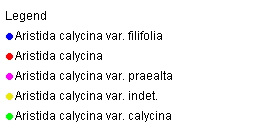Aristida calycina R.Br. Prodr. 173
(1810).
Classification. (GPWG 2001) : Subfamily
Aristidoideae. Aristideae.
Type of Basionym or
Protologue Information: LT: Brown 6198, 14 Aug 1802, Australia:
Queensland: Port Curtis Dist.: Keppel Bay (K; IT: BM, BRI, E,). LT designated
by Henrard, Meded. Rijks Herb. 54: 71 (1926).
Recent synonyms:
Aristida armata Henrard, Aristida praealta (Domin) Henrard,
Aristida glumaris Henrard.
Key references
(books and floras): [1810]. R.Brown, Prodromus (173), [1878]
G.Bentham, Flora Australiensis 7 (563), [1981] M.Lazarides in J.Jessop
(ed)., Flora of Central Australia (449 & 450 as A. praealta),
[2002] D.Sharp & B.K.Simon, AusGrass, Grasses of Australia, [2008]
S.W.L.Jacobs, R.D.B.Walley & D.J.B.Wheeler, Grasses of New South Wales
(127).
Illustrations:
[1983] J.C.Tothill & J.B.Hacker, Grasses of Southern Queensland
(106(40)), [2008] S.W.L.Jacobs, R.D.B.Whalley & D.J.B.Wheeler, Grasses
of New South Wales, 4th edn (127).
Derivation: Gk.
kalyx, cup; -ina, belonging to.
Habit.
Perennial. Culms erect, 33–128 cm tall. Mid-culm internodes glabrous. Lateral
branches sparsely branched or branched. Leaf-sheaths smooth to antrorsely
scabrous, glabrous on surface. Ligule a fringe of hairs, 0.3–1 mm long.
Leaf-blades straight, filiform or linear, flat or conduplicate or involute or
convolute, 20–25 cm long, 1–4 mm wide. Leaf-blade surface smooth or scabrous.
Inflorescence.
Inflorescence compound, a panicle or a panicle. Panicle linear to elliptic,
12–31.5 cm long, 2–20 cm wide.
Spikelets.
Spikelets pedicelled. Fertile spikelets 1-flowered, comprising 1 fertile
floret(s), without rachilla extension, lanceolate, terete, 5.5–20 mm long.
Glumes.
Glumes similar, thinner than fertile lemma. Lower glume lanceolate, membranous,
keeled, 1-keeled, 1–7 -nerved. Lower glume surface glabrous or indumented.
Lower glume apex muticous or mucronate. Upper glume lanceolate, 5.5–20 mm long,
membranous, keeled, 1-keeled, 1 -nerved. Upper glume surface smooth to
scabrous, glabrous or indumented. Upper glume apex entire or erose, muticous or
mucronate.
Florets.
Fertile lemma 4–14 mm long, without keel, 3 -nerved. Lemma apex awned, 3
-awned. Median (principal) awn without a column. Lateral lemma awns present.
Palea without keels. Anthers 3. Grain 3–5 mm long.
Continental
Distribution: Australasia.
Australian
Distribution: Western Australia, Northern Territory, Queensland, New South
Wales, Victoria.
Western Australia:
Giles, Fortescue. Northern Territory: Darwin & Gulf, Barkly
Tableland, Central Australia North, Central Australia South. Queensland:
Burke, Burnett, Cook, Darling Downs, Gregory North, Leichhardt, Maranoa,
Mitchell, Moreton, North Kennedy, Port Curtis, South Kennedy, Warrego, Wide
Bay. New South Wales: North-Western Slopes, North-Western Plains. Victoria:
Eastern Highlands, Midlands.
Notes. A. calycina differs from A. benthamii and A. jerichoensis by its
larger spikelets and from A. acuta by the glumes not being awned and by
the inflorescence branches usually bearing spikelets throughout its length. It
also usually has prominent pulvini in the axes of the inflorescence branches.
The glumes may be inverse. Three varieties are recognised - var. praealta with
tuberulate lemma furrows and var. calycina and var. filifolia without
tuberculate lemma furrows; the latter variety has filiform leaf blades.
Infra-specific taxa: var. calycina, var. filifolia, var. praealta.
Margins of lemma
furrow with one to several rows of tubercles A. calycina var. praealta
Margins of lemma
furrow smooth or lemma muricate towards apex
Leaf blades filiform
and arranged basally on culm A. calycina var. filifolia
Leaf blades not as
above A. calycina var. calycina



